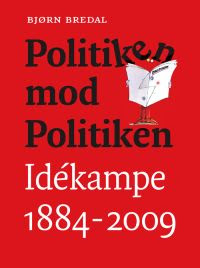 The Danish broadsheet Politiken is by many, including me, considered the best and most prestigious newspaper in Scandinavia. Bjørn Bredal’s book Politiken mod Politiken – Idékampe 1884-2009, published on the occasion of the newspaper’s 125th anniversary last October, is a fascinating account of Politiken and some of the tensions which have put their mark on its history.
The Danish broadsheet Politiken is by many, including me, considered the best and most prestigious newspaper in Scandinavia. Bjørn Bredal’s book Politiken mod Politiken – Idékampe 1884-2009, published on the occasion of the newspaper’s 125th anniversary last October, is a fascinating account of Politiken and some of the tensions which have put their mark on its history.Politiken was founded in 1884 by a group of radicals, including Viggo Hørup and Edvard Brandes, during the political struggle which ended in the introduction of parliamentarianism in 1901. It was an explicit purpose of Politiken to advocate a certain set of ideas, making it what one would today call a viewspaper rather than a newspaper.
In 1905 Henrik Cavling changed it in the direction of a more objective newspaper. However, the same year several of Politiken’s leading men founded the Danish Social Liberal Party and many of them would thereby find themselves in parliament and government. Thus the Social Liberal Party was not, like many other parties, a party with a newspaper, but Politiken was a newspaper with a party, whose parliamentary group meetings it attended.
The formal ties between the newspaper and the party were cut in 1970, but Politiken continues to be what is in Danish called a “culture-radical” newspaper left of the centre. Following the political earthquake of 2001, which brought an end to the normal situation that governments of both left and right would need the support of a centre party to form a majority, replacing it with a right-wing government supported by the far right-wing, it has occasionally been said that Politiken’s high-profile editor-in-chief, Tøger Seidenfaden, is the real leader of the opposition rather than the meek Social Democrat Helle Thorning-Schmidt.
The balance between newspaper and viewspaper has continued to be a central challenge for Politiken, which has also seen many internal disputes over its direction. This became very obvious earlier this month, when Seidenfaden publicly regretted having reprinted Jyllands-Posten’s infamous Mohamed caricature, something which caused 38 members of the editorial staff to write an op-ed (hardly ever has that word been more precise) protesting against the editor’s apology.
Bjørn Bredal’s book is not a chronological history of the newspaper, although the chapters are interspersed with facsimiles and excerpts from its history, focusing on the year it was founded and its 25th, 50th, 75th, 100th and 125th anniversary years. This works very well as Politiken has traditionally paid much attention to its layout, making it one of the most well-designed newspapers in Europe (it is almost alone in Scandinavia in sticking to the broadsheet format). The book is also in itself well designed and illustrated.
Bredal charts the newspaper’s history and development through looking at some central topics of controversy and how these have been dealt with by Politiken throughout is history. Among them is the issue of gender and morality; Israel, Zionism and anti-Semitism (a number of Jews have held important posts at the newspaper); sports; the arts; and war and foreign policy.
A chapter I personally found particularly interesting is the one dealing with the Easter crisis of 1920 and the caricature crisis of 2005 (and after). The first nearly broke Politiken as it referred to King Christian X’s dismissal of Prime Minister Carl Th. Zahle, ninety years ago on this very day, as a “coup d’état”, a choice of word which Henrik Cavling realised was a mistake as it again made Politiken a political weapon more than a reporting newspaper. This put Politiken in the same category as Social-Demokraten and cost it a huge number of subscribers and advertisers, very nearly ruining the newspaper.
(It was therefore interesting to note six days ago, after I had finished the book, that one of Politiken’s editors, Lars Trier Mogensen, used exactly the word “coup d’état” about the Easter crisis in an article where he called for the monarchy to be completely severed constitutionally from politics).
Bjørn Bredal’s book is essential reading for anyone interested in or wanting to understand the unique newspaper concept that is Politiken. And in its own way it is also a book which says much about Danish history, politics and culture in general.





No comments:
Post a Comment
Comments are welcome, but should be signed - preferably by a name, but an initial or a nick will also be accepted. Advertisements are not allowed. COMMENTS WHICH DO NOT COMPLY WITH THESE RULES WILL NOT BE PUBLISHED.